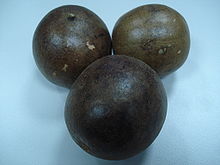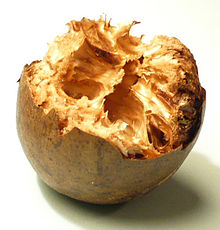- Siraitia grosvenorii
-
Siraitia grosvenorii 
Siraitia grosvenorii (luohan guo) fruits Scientific classification Kingdom: Plantae (unranked): Angiosperms (unranked): Eudicots (unranked): Rosids Order: Cucurbitales Family: Cucurbitaceae Subfamily: Cucurbitoideae Tribe: Joliffieae Subtribe: Thladianthinae Genus: Siraitia Species: S. grosvenorii Binomial name Siraitia grosvenorii
(Swingle) C.Jeffrey ex A.M.Lu & Zhi Y.ZhangSiraitia grosvenorii is an herbaceous perennial vine native to southern China and Northern Thailand. The plant is best known for its fruit, commonly called luo han guo or luo han kuo (from the Chinese luóhàn guǒ, 羅漢果, 罗汉果, sometimes printed lohoguo in Hong Kong[1]), la han qua (from Vietnamese la hán quả), arhat fruit, Buddha fruit, or monk fruit. Botanical synonyms include Momordica grosvenorii and Thladiantha grosvenorii. The fruit is one of several that have been called longevity fruit.[2] The species was named in honor of Gilbert Grosvenor.
The plant is cultivated for its fruit, used for cooling drinks and in traditional Chinese medicine. The fruit extract is nearly 300 times sweeter than sugar and has been used as a natural low-calorie sweetener in China for nearly a millennium to treat diabetes and obesity[2]
Contents
Description
The vine attains a length of 3 to 5 m, climbing over other plants by means of tendrils which twine round anything they touch. The narrow, heart-shaped leaves are 10–20 cm long. The fruit is round, 5–7 cm in diameter, smooth, yellow-brownish or green-brownish colour, with a hard but thin skin covered by fine hairs. It contains a sweet, fleshy, edible pulp and numerous seeds.
Cultivation
It is grown primarily in the far southern Chinese province of Guangxi (mostly in the mountains near Guilin), as well as in Guangdong, Guizhou, Hunan, and Jiangxi provinces. These mountains lend the plants shadows and often are surrounded by mists; because of this the plants are protected from the sun. Nonetheless, the climate in this southern province is warm. The plant is rarely found in the wild and has hence been cultivated for hundreds of years.
Records as early as 1813 mention the cultivation of this plant in the Guangxi province.[3][unreliable source?] At present, the Guilin mountains harbor a plantation of 16 square kilometers with a yearly output of about 10,000 fruits. Most of the plantations are located in Yongfu County and Lingui County, which in China are renowned for the extraordinary number of centenarians. This is sometimes attributed to the consumption of this fruit and the unspoiled nature. The locals, however, believe in their calm lifestyle and simple diet.
Longjiang Town in Yongfu County has acquired the name "home of the Chinese luohanguo fruit"; a number of companies specialised in making luohanguo extracts and finished products have been set up in the area. The Yongfu Pharmaceutical Factory is the oldest of these.
Traditional uses
The plant is most prized for its sweet fruits, which are used for medicinal purposes, and as a sweetener.[4] The fruits are generally sold in dried form, and traditionally used in herbal tea or soup. They are used for heat stroke, sore throat, chronic cough, and constipation, and are reputed to aid longevity. The fruit is also used as a natural sweetener in the treatment of diabetes and obesity.[5]
Toxicity
There are no reported incidents of negative side effects of luohan guo. It is classed by the US Food and Drug Administration as a GRAS (generally recognized as safe) product. There are no restrictions on consuming the fruit or its extracts.
Active agents
The sweet taste of the fruit comes mainly from mogrosides, a group of triterpene glycosides that make up approximately 1% of the flesh of the fresh fruit. Through solvent extraction, a powder containing 80% mogrosides can be obtained, the main one being mogroside-5 (esgoside) Other similar agents in the fruit are siamenoside and neomogroside.[6]
Recent research suggests that isolated mogrosides work have antioxidant properties[7] and may have limited anti-cancer effects.[8][9]
Mogrosides have also been shown to inhibit induction of Epstein-Barr virus in vitro.[10]
The plant also contains a glycoprotein called momorgrosvin, which has been shown to inhibit ribosomal protein synthesis[11]
Cultivation and marketing
Traditional processing
Luohan guo is harvested in the form of a round green fruit, which becomes brown on drying. It is rarely used in its fresh form, as it is hard to store. Furthermore, it develops a rotten taste on fermentation, which adds to the unwanted flavours already present.
Thus the fruits are usually dried before further use and are sold in precisely this fashion in Chinese herbal shops. The fruits are slowly dried in ovens, preserving them and removing most of the unwanted aromas. However, this technique also leads to the formation of several bitter and astringent aromas. This limits the use of the dried fruits and extracts to the preparation of diluted tea, soup, and as a sweetener for products that would usually have sugar or honey added to them.[12]
The Procter & Gamble process
The process for the manufacture of a useful sweetener from luo han guo was patented in 1995 by Procter & Gamble. The patent states that, while luo han guo is very sweet, it has too many interfering aromas, which render it useless for general application. Thus the company developed a process for the removal of the interfering aromas.
In this process, the fresh fruit is harvested before it is fully mature, and is then matured in storage so that it may be processed precisely when it is mature. The shell and seeds are then removed, and the pulped fruit is made into a fruit concentrate or puree. This is then used in the further production of food. Solvents are used, amongst other things, to remove the interfering aromas.
Products
There are a number of commercially prepared luohan guo products:
Powdered instant luohan guo is sold by the Yongfu company in China, Hong Kong and in Chinese shops in the West.
There are a number of other products which contain luohan guo either on its own or in a mix with other herbs. For example it is used with Ginkgo biloba against cough, with chrysanthemum against heatstroke and headache or with asparagus, Oldenlandia, Scutellaria, and pearl powder to detoxify.
Recently, IZZE beverage company debuted a line of low-calorie juices using luo han guo as a sweetener.
Celestial Seasonings has a winter holiday tea called Gingerbread Spice that lists it as the last ingredient.
Quest Nutrition uses it as a sweetener along with sucralose in their protein bars.
Kashi uses luohan guo concentrate in its Berry Blossoms and Honey Sunshine cold cereal.
An extract of the fruit, along with erythritol is also used by the Japanese company Saraya Corporation for manufacturing of the sugar substitute Lakanto, for people following a candida control diet.
History
During the Tang dynasty, Guilin was one of the most important Buddhist retreats containing many temples. The fruit was named after the arhats (Chinese: 羅漢; pinyin: luóhàn), a group of Buddhist monks who, due to their proper way of life and meditation, achieved enlightenment and were said to have been redeemed. According to Chinese history, the fruit was first mentioned in the records of the 13th century monks who used it.
However, plantation space was limited: it existed mainly in the slopes of the Guangxi and Guangdong mountains, and to a lesser degree in Guizhou, Hunan, Jiangxi, and Hainan. This and the difficulty of cultivation meant that the fruit did not become part of the Chinese herbal tradition, which depended on more readily available products. This is also the reason why one finds no mention of it in the traditional guides to herbs.
Western rediscovery in the 20th century
The herb became better known to the West in the 20th century. The first report on the herb in English was found in an unpublished manuscript written in 1938 by Professor G. W. Groff and Hoh Hin Cheung. The report stated that the fruits were often used as the main ingredients of "cooling drinks," that is, as remedies for hot weather, fever, or other dysfunctions traditionally associated with warmth or heat (i.e. inflammation).
It was known that the juice of the fruits was very sweet.
Groff and Hoh realised that the fruit was an important Chinese domestic remedy for the treatment of cold and pneumonia when consumed with pork.
Interviews have confirmed that the fruit only recently gained importance in Chinese history. Nonetheless, it appears that a small group of people had mastered its cultivation a long time ago and had accumulated extensive knowledge on growth, pollination, and climatic requirements of the plant.
The fruit came to the United States in the early 20th century. Groff mentions that during a visit to the American ministry of agriculture in 1917, the botanist Frederick Coville showed him a luohanguo fruit bought in a Chinese shop in Washington. Seeds of the fruit which had been bought in Chinese shop in San Francisco were entered into the universal botanic description of the species in 1941.
The first research into the sweet component of luohan guo is attributed to C. H. Lee, who wrote an English report on it in 1975, and also to Tsunematsu Takemoto, who worked on it the early 1980s in Japan (later Takemoto decided to concentrate on the similar sweet plant, jiaogulan).
The development of luohan guo products in China has continued ever since, focusing in particular on the development of concentrated extracts.
References
Much of the content of this article comes from the equivalent German-language Wikipedia article (retrieved February 16, 2006).
- ^ seen on a packet produced by Wai Hong Hong Ltd
- ^ a b Ling Yeouruenn, A New Compendium of Materia Medica, 1995 Science Press, Beijing.
- ^ Dragon River Health Products, http://www.dragonriver.net/eng/home.html
- ^ Kinghorn AD and Soejarto DD, Discovery of terpenoid and phenolic sweeteners from plants, Pure Applied Chemistry 2002; 74(7): 1169-1179.
- ^ Dai Yin-Fang and Liu Cheng-Jun, translated by Ron Edwards and Gong Zhi-Mei (1986), "Fruits As Medicine: A Safe and Cheap Form of Traditional Chinese Food Therapy". The Ram's Skull Press, Kuranda, Australia.
- ^ Subhuti Dharmananda, "Luo Han Guo - Sweet Fruit Used as Sugar Substitute and Medicinal Herb". From the Institute for Traditional Medicine website.
- ^ Shi H, et al. (1996). "Antioxidant property of fructus momordicae extract". Biochemistry and Molecular Biology International 40 (6): 1111–1121. PMID 8988323.
- ^ Konoshima T and Takasaki M (2002). "Cancer-chemopreventive effects of natural sweeteners and related compounds". Pure Applied Chemistry 74 (7): 1309–1316. doi:10.1351/pac200274071309. http://www.iupac.org/publications/pac/2002/pdf/7407x1309.pdf.
- ^ Katiyar SK and Mukhtar H (1997). "Tea antioxidants in cancer chemoprevention". Journal of Cellular Biochemistry 27: 59–67. PMID 9591194.
- ^ Akihisa, T; Hayakawa, Y; Tokuda, H; Banno, N; Shimizu, N; Suzuki, T; Kimura, Y (2007). "Cucurbitane glycosides from the fruits of Siraitia gros venorii and their inhibitory effects on Epstein-Barr virus activation". Journal of natural products 70 (5): 783–8. doi:10.1021/np068074x. PMID 17477572.
- ^ Tsang, K.Y. and T.B. Ng (2001). "Isolation and characterization of a new ribosome inactivating protein, momorgrosvin, from seeds of the monk's fruit Momordica grosvenorii". Life Sciences 68 (7): 773–784. doi:10.1016/S0024-3205(00)00980-2. PMID 11205869.
- ^ Hsu HY, et al., Oriental Materia Medica, 1986 Oriental Healing Arts Institute, Long Beach, California
External links
Categories:- Cucurbitaceae
- Fruits originating in Asia
- Flora of China
- Flora of Thailand
- Crops originating from China
- Chinese ingredients
- Vietnamese ingredients
- Plants used in Traditional Chinese medicine
- Medicinal plants
- Dietary supplements
- Sweeteners
- Tropical fruit
- Herbs
Wikimedia Foundation. 2010.

